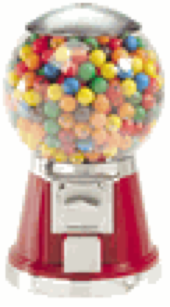A gum chewing girl and a cud chewing cow,
There is some difference, I will allow.
What is that difference? Awe, I have it now.
It’s that contented look on the face of the cow.
Back in September 2003 the question came up in the Riverside Review whether chewing gum loses its flavor on the bedpost overnight. It seems that the popular 1930s song (Is it yes or is it no?) gave no answer to this burning question that was on everyone’s mind at that time. If there is an answer, it may be found in the long history of chewing gum.
Evidence of gum chewing dates back to prehistoric men and women who chewed on tree resin for enjoyment. Greek and Middle Eastern cultures routinely chewed resin from the mastic tree to freshen their breath. In Central America, the Mayans enjoyed chewing on chicle sap. In the United States, Native Americans and settlers first chewed on spruce tree resin and beeswax. In 1848, John B. Curtis made and sold the first commercial chewing gum called “State of Maine Pure Spruce Gum.” He sold two hunks of the gum for a penny. Then later in 1850, he began selling flavored paraffin gums. It wasn’t until 1869 that William Finley Semple became the first person to patent a chewing gum - U.S patent #98,304.
There was a photographer by the name of Thomas Adams (1818-1905) who befriended the Mexican General, Antonio Lopez de Santa Anna. The General had attack the Alamo and was then living in exile on Staten Island. The two men discussed profitable ways to use the chicle sap from Mexican sapodilla trees. Adams first tried to mix it with rubber to make a better bicycle tire. Then he tried making toys, masks, and rain boots, but every experiment failed. One day in 1869, he popped a piece of surplus stock into his mouth and enjoyed the experience of chewing it. Maybe others would enjoy his chicle gum. He went to work on the idea and in1871 Adams received the first patent on a gum-making machine and began mass producing a chicle-based gum. His first gum ("Snapping and Stretching") was pure chicle with no flavoring, but sold well enough to encourage Adams. He began to experiment with flavorings, beginning with sarsaparilla. In 1884, he added a licorice flavoring and called his invention Adams' Black Jack, the first flavored gum in America.
In 1888, Adams introduced a new chewing gum called Tutti-Frutti. It became the first gum to be sold in vending machines. These machines were located on the elevated subway platforms in New York City. By the end of the 19th century the Adams firm was the nation's most prosperous chewing gum company. In 1899 it became a monopoly by merging with the six largest and best-known chewing gum manufacturers in the United States and Canada, and achieved great success as the maker of Chiclets.

Beemans Chewing Gum was originally invented in 1898 as a cure for heartburn. Clove Gum got a boost during Prohibition when it was handed out as a breath freshener in illegal liquor houses. Interesting enough, the Warner-Lambert Pharmaceutical Company reintroduced the 100-year-old Black Jack, Beemans, and Clove gums in 1986.
As a young child I was very careful when chewing gum since I had heard that if swallowed, the gum would take seven years to pass through my stomach. Back in the 1930s and 40s, we kids would have gum stretching contests and sit in the back of movie theaters making popping sounds to annoy the audience. A few of my grade school friends got a kick out of putting gum in girl’s hair. Their dirty deed seemed like a clever way to make the girls notice you. I also remember separating the shiny foil from the gum wrappers and folding it in a manner that made a silver chain. In retrospect, chewing gum played an important part during my dating years. A fresh stick of gum gave me the confidence my breath would be pleasing to my girlfriend(s).
Today, people chew gum in an effort to quit their unhealthy habit of smoking. Unfortunately they have acquired another bad habit of attaching their unwanted gum to the bottom of theater seats, tables, and chairs. Sidewalks are another favorite spot for people to discard their chewing gum after it has entirely lost its flavor. A few penny-pinching persons have been known to scrounge a stick of gum from a friend and then place the chewed gum on their bedpost at night to be retrieved the next morning.
